The upcoming James Webb Space Telescope will allow astronomers to peer deeper than ever before into the history of the early universe, according to Marcia Rieke, principal investigator for the Near Infrared Camera of the Webb telescope.
As principal investigator, Rieke is responsible for overseeing the construction of the NIRCam, which entails working alongside the engineers who built the camera as well as making sure that the project is completed on time and within budget.
Rieke said the Webb telescope is currently undergoing testing at the NASA Goddard Space Flight Center in Maryland. The NIRCam was built at Lockheed Martin in Tucson.
Brenda Frye, assistant astronomer in the Department of Astronomy and Steward Observatory at the UA, said the Webb telescope will be unlike any other space-based telescope to date.
“It’s larger than anything we have had before, more sensitive than anything we have had before and with far better instrumentation and technology,” Frye said.
Working with infrared allows astronomers to observe more light than the human eye has the ability to detect.
Don McCarthy, an astronomer at the Steward Observatory who worked on the NIRCam for the Webb telescope, said any mass that has heat emits its own light in the form of infrared.
This means Earth’s atmosphere glows in infrared light even at night, which drowns out much of the starlight behind it. This makes it difficult to use an infrared telescope to the best of its ability when stationed below the atmosphere.
That is why the Webb telescope is planned to launch into orbit around the Sun, about 1 million miles away from Earth’s orbit. Occupying an orbit of that distance from Earth will make it impossible for any repairs to be made once the telescope is in space.
“I think the single biggest thing is figuring out how to make this all work without you ever touching it,” Rieke said.
While the Hubble Space Telescope is kept at about 76 degrees Fahrenheit, Rieke said the Webb telescope will maintain a temperature of around 40 degrees above absolute zero. This is to ensure that it can optimally capture faint and distant light in infrared wavelengths without disturbances from any unnecessary heat signatures.
The Webb telescope will allow astronomers to observe objects within our universe at greater distances than before.
“[The mirror is] 6.5 meters across instead of only 2.4 meters across,” Rieke said. “So the diameter is almost a factor of three different and that means that the area, if you go through the numbers, collects about eight times as much light.”
This powerful new telescope will attempt to fill in some of the missing pieces of the cosmological time line concerning how the universe evolved, from the point of the big bang to the formation of the first stars and galaxies.
“We know that we go from these clumps of hydrogen to these things that look like baby galaxies and so the goal is to fill in those details,” Rieke said.
Astronomers also plan to study the composition of these young stars and galaxies which formed early in our universe’s history.
“It will be very interesting to see what we measure from those very young galaxies, in terms of how much carbon, oxygen, nitrogen they have compared to what we see now,” Rieke said.
Identifying these early stars is possible because they possess a different compositional make up than those that formed later on. It is thought that the first generation of stars were composed almost entirely of hydrogen, helium and bits of lithium.
Heavier elements beyond that are created and dispersed throughout the universe when stars die in the form of violent explosions known as supernovae.
“When [stars] blow up, they deposit lots of heavy elements out into space, which are then incorporated into the next generation of stars and planets,” Rieke said.
The Webb telescope should be able to answer many questions surrounding the early stages of evolution within our universe. The telescope is scheduled to launch in 2018.
Follow Steve Preston on Twitter.









